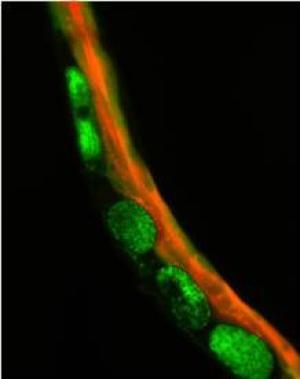摘要:研究人员发现土壤或实验室养的蠕虫线虫缺少一种蛋白就不能将从食物中摄取的铁运输到身体的其他部分或它们自身发育的胚胎中,这一研究结果发表在5月27日得细胞杂志上,为蠕虫、动物包括人类在内的基本要素运输研究提供了重要的见解。

Heme (red) is eaten by an pregnant worm.
Researchers say it also suggests a strategy for the development of drugs aimed at parasitic worms, which affect more than a quarter of the world's human population and cause tens of billions of dollars of loss in animal and plant production annually. Like C. elegans, parasitic helminths such as hookworms don't produce any of their own heme as other animals and bacteria do. That means they are crucially dependent on heme from external sources and on the newly discovered transport pathway. When the pathway doesn't function properly, they are unable to produce live offspring.
Heme is probably most familiar as a critical component of the oxygen-carrying protein, hemoglobin, which makes our blood red, the researchers explained. C. elegans worms don't have hemoglobin, but they do have other globins that carry oxygen through their circulation.
"Hemoglobin was one of the first protein structures known," said Iqbal Hamza of the University of Maryland, College Park. "For over 60 years, nobody knew how heme gets into globin or within or between cells. It's so important because the majority of the world's population suffers from iron deficiency and a diet rich in iron contained within heme is more easily absorbed by humans."
To sort the transport pathway out, Hamza looked not to humans or mice but to C. elegans, precisely because the worms don't make heme at all. Those studies led his team a few years ago to a breakthrough: the first bona fide heme importer in a multicellular organism, called HRG-1. HRG-1 is needed to get heme from the diet into the intestine. But what brings heme from the intestine into the circulation?
"Now, this study takes the pathway to the next level," he says. They find that a tiny protein called HRG-3 takes that heme from the intestine to other parts of the worms' body -- their brains and skin, for example -- and, perhaps most importantly, to their many embryos.
In the absence of HRG-3, heme accumulates in the intestine of pregnant mothers. Consequently, their embryos become heme deficient and either die or stop growing immediately after hatching.
The findings in C. elegans may have implications for humans and parasitic worms. "C. elegans has been a beautiful incubator for gene discovery," Hamza said. His team has taken advantage of powerful genetic approaches available by studying worms and then "superimposed those discoveries on humans and parasites."
Once you understand the transport of heme, it may be possible to more effectively deliver it for better absorption of iron in the human intestine, he said. It might also uncover what Hamza calls a "universal Achilles heel" for targeting the parasites that are a particular problem for people in developing countries, such as Hamza's native India.
"Anthelminthics are becoming less effective in humans and livestock because of rampant drug resistance," the researchers wrote. "We propose that an excellent anthelminthic target would be the HRG-3-mediated pathway for transporting heme to developing oocytes, especially in parasites such as hookworms, which infect more than a billion people worldwide and feed on host red blood cell hemoglobin."







